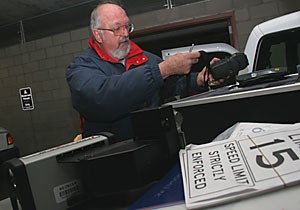The gun Larry Forchione uses almost every day is heavy and loud; if you make a habit of speeding in campus parking garages, you might want to watch out for him.
Of course, the most you’ll have to fear is a speeding ticket.
Forchione, an officer with Parking and Transportation Services, uses a camera mounted on a laser gun to catch people exceeding the 15 mph speed limit in garages.
Last semester, PTS handed out 42 citations for moving violations, including speeding and failing to yield, said David Heineking, PTS associate director.
All of those citations came after the beginning of October, Heineking said. Prior to that, campus drivers had a six-week grace period when the department issued 190 warnings but no tickets.
In addition to its new policy of issuing those sorts of tickets, PTS raised the speed limit in parking structures from 5 mph.
Heineking said the drop in violations could be due to drivers paying more attention to enforcement officers who do their job in plain sight.
“”When we have the laser out, we don’t hide,”” Heineking said. “”We want people to know that we’re out there looking.””
Forchione said he thought there would be more moving violations than there were.
“”I’m just very surprised we haven’t had more fender benders,”” Forchione said.
The laser gun sends out 250 pulses per second, which it uses to track the speed of the vehicle and cause the camera to take a photo, Forchione said.
After taking the photo, Forchione said he uses a hand-held unit, something like an oversized Palm Pilot, to write the ticket, and later uploads the information to the PTS computer system.
From there, PTS sends out tickets based on information from its database and the license plate numbers from the photos.
For violations other than speeding, officers personally observe and record the vehicle’s details, then follow the same procedure.
Forchione said enforcement officers from PTS are not supposed to have any face-to-face contact with the people they are citing.
Forchione added that while the vast majority of people who use garages on campus are safe drivers, none of the enforcement officers are overzealous in their pursuit of those who aren’t.
Susannah Maurer, an assistant curator in the UA Museum of Art who parks in the Park Avenue Parking Garage, said she doesn’t think drivers are that reckless.
Carl Johnson, an undeclared freshman, said because of his own experience, he isn’t surprised that PTS would take those steps.
Johnson, who also uses the Park Avenue Parking Garage, said he was rounding a corner when another driver began to pull out and he narrowly missed hitting the other car by slamming on his brakes.
Heineking said PTS will be doing a study of accidents and speeding in the garages this spring to complement the 2006 study that prompted the new regulations.
“”I would hope that when people know that there could be some penalties for disobeying the traffic control devices they’ll think twice before doing it,”” Heineking said.









